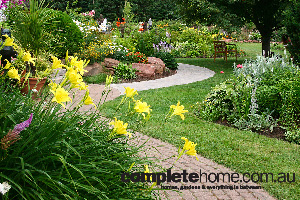There is nothing as cooling on a summer’s day than to relax in a tropical-style garden
The relaxed ambience of a tropical garden setting can be easily achieved. All you need to do is follow a few simple steps. Whether your landscape space is large or small, by applying some basic design principles you can enhance and enliven your outdoor lifestyle space on any scale.
Think twilight dining amid lush, layered foliage and soft breezes at sunset. Tropical … even the word evokes images of coconut trees, warm temperatures and evenings spent sipping Long Island iced teas. Sound like a relaxing place to be? You can garden your way to your dream holiday setting in your own backyard!
Multileveled plant layouts, textured foliage, brilliant colour and dense planting strategies are all key components in achieving a successful tropical landscape theme. Consider the primary use of the space and where you will tend to entertain and dine. This is where the bulk expenditure of your garden renovation should take place. Particular emphasis on focal areas and the incorporation of premium plant cultivars, larger plants and flowering species will help to create an instant sense of ambience.
Let go of the urge to install straight lines and sharp angles. Tropical gardening is all about movement and colour. Undulating garden shapes and ambling walkways all give a sense of journey to the space, encouraging the viewer to curiosity and exploration.
A combination of broad foliage, leaf and flower colour, height, texture and form all play an essential role in giving a garden a strong sense of “a world unto its own”. Listed below is a range of great performers that can be used as a palette of sorts from which to choose your own tropical adventure:
– Upper layer/canopy: Giant bird of paradise, alexander palm, foxtail palm, jacaranda, red poinciana and screwpine.
– Mid layer: Cordyline, variegated shell ginger, Codiaeum variegatum ‘Mammy’, Dracaena marginata ‘Tricolour’, Phormium tenax ‘Anna’s Red’, Mauritius hemp, tiger grass, dwarf bird of paradise, Spathiphyllum ‘Sensation’, cascade palm, rhapis palm, giant elephant’s ears.
– Ground layer: Spider lily, New Guinea impatiens, soft-tip agave, giant bromeliad, Rhoeo discolour, blechnum fern, Lomandra longifolia, Kalanchoe ‘Flapjacks’ and Coleus ‘Frogsfoot’.
Some tropical plant species are particularly sensitive to cooler temperatures and frost. Check with your local nursery for a shortlist of plant species that are most likely to perform well in your area.
Tropical-style plantings respond well to richly composted soils and regular organic fertiliser applications. Minimal pruning is required for established gardens and many of these plant species will grow happily for years, virtually undisturbed.
Bringing your landscape to life can be accomplished by adding detailed touches that will ignite your garden setting. Use natural materials for mulch, such as bark. You can then complement this mulch layer with areas of pebble or stone. These can be applied as a gentle edge to pathways or laid as mulching to highlight grouped plantings in selected garden beds. Charcoal-coloured river rock provides a wonderful depth to surrounding plant life, while larger stone sizes of 75–150mm offset broad foliage beautifully.
Uplift your chosen theme with ambient lighting, comfortable seating and covered entertaining areas. Include solid elements that will help to give grounding and focus to the landscape, while leading the eye to unknown corners and hidden aspects. Balinese-style huts and daybeds provide a welcome refuge from the elements and are well worth the investment.
For a final touch, introduce the soft trickle of a subtle water feature — this will bring a sense of calm and tranquility. Also include a stone urn or natural rock waterfall that will blend with the tropical planting and inspire thoughts of far-flung places.




